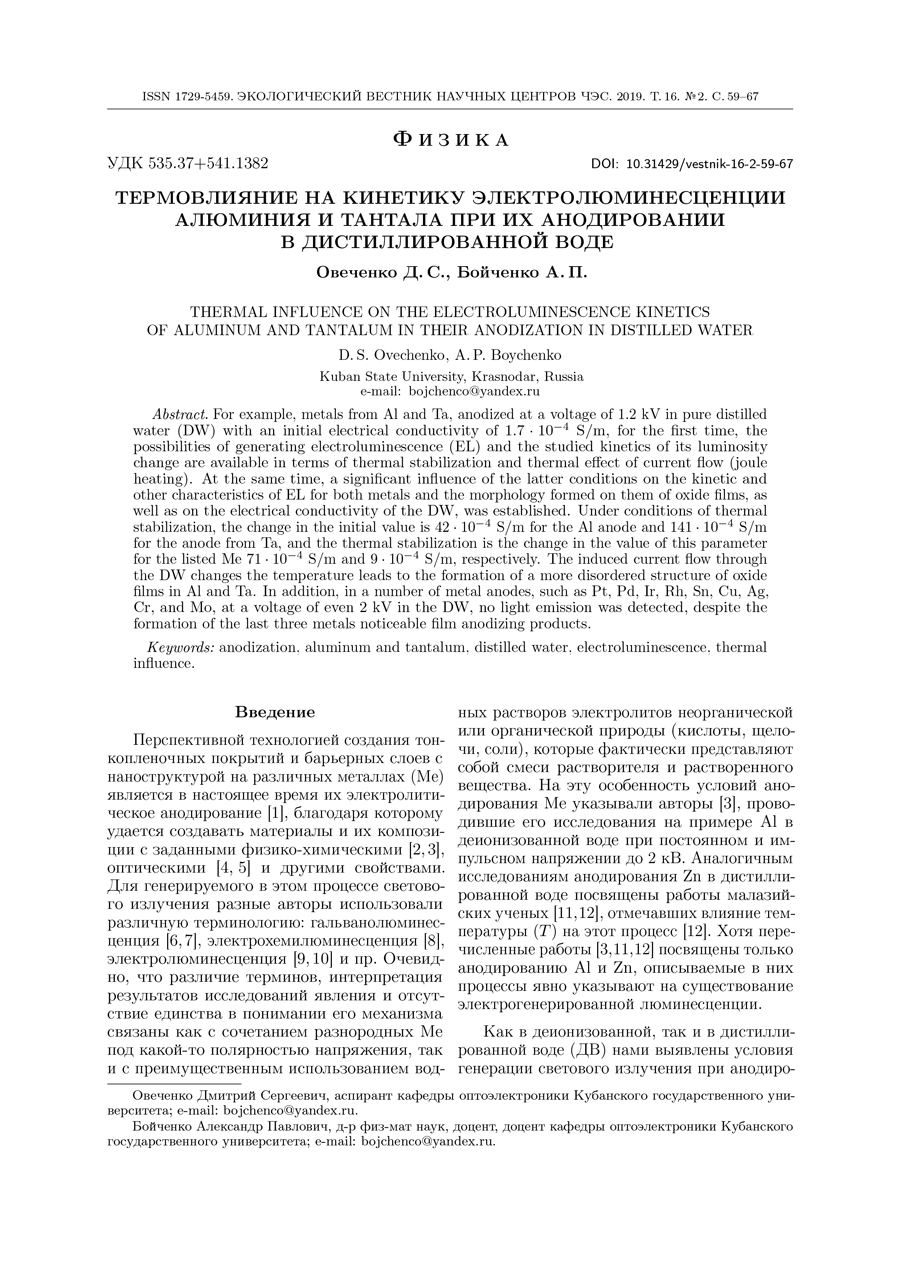Thermal influence on the electroluminescence kinetics of aluminum and tantalum in their anodization in distilled water
UDC
535.37+541.1382DOI:
https://doi.org/10.31429/vestnik-16-2-59-67Abstract
For example, metals from Al and Ta, anodized at a voltage of 1.2 kV in pure distilled water (DW) with an initial electrical conductivity of 1.7·10-4S/m, for the first time, the possibilities of generating electroluminescence (EL) and the studied kinetics of its luminosity change are available in terms of thermal stabilization and thermal effect of current flow (joule heating). At the same time, a significant influence of the latter conditions on the kinetic and other characteristics of EL for both metals and the morphology formed on them of oxide films, as well as on the electrical conductivity of the DW, was established. Under conditions of thermal stabilization, the change in the initial value is 42·10-4 S/m for the Al anode and 141·10-4 S/m for the anode from Ta, and the thermal stabilization is the change in the value of this parameter for the listed Me 71·10-4 S/m and 9·10-4 S/m, respectively. The induced current flow through the DW changes the temperature leads to the formation of a more disordered structure of oxide films in Al and Ta. In addition, in a number of metal anodes, such as Pt, Pd, Ir, Rh, Sn, Cu, Ag, Cr, and Mo, at a voltage of even 2 kV in the DW, no light emission was detected, despite the formation of the last three metals noticeable film anodizing products.
Keywords:
anodization, aluminum, tantalum, distilled water, electroluminescence, thermal influenceReferences
- Aver'yanov, E.E. Spravochnik po anodirovaniyu [Anodizing Guide]. Moscow, Mashinostroenie, 1988, 224 p. (In Russian)
- Hickmott, T.W. Voltage-controlled negative resistance and electroluminescent spectra of Al-Al2O3-Au diodes. J. Appl. Phys., 2009, vol. 106, pp. 103719 (1–9). DOI: 10.1063/1.3262619
- Lisenkov, A.D., Poznyak, S.K., Zheludkevich, M.L., Ferreira, G.S. Aluminum anodization in deionized water as electrolyte. J. Electrochem. Soc., 2016, vol. 163, pp. C364–C368. DOI: 10.1149/2.0881607jes
- Dlugunovich, V.A., ZHumar', A.Yu., Kurilkina, S.N., Muhurov, N.I. Preobrazovanie polyarizacii sveta s ispol'zovaniem nanoporistyh plenok oksida alyuminiya [Light Polarization Conversion Using Nanoporous Aluminum Oxide Films]. Zhurnal prikladnoy spektroskopii [J. of Applied Spectroscopy], 2015, vol. 82, no. 5, pp. 766–772. (In Russian)
- Jian-Jun, Gu, Shu-Min, Yang, Meng-Yao, Dong, Yun-Kai, Qi. Study on magnetic and optical properties of porous anodic alumina/Co composite films with rainbow structural color prepared by an annular carbon electrode. J. Alloys Comp., 2017, vol. 728, pp. 93–99. DOI: 10.1016/j.jallcom.2017.08.272
- Gardin, Yu.E., Kulabukhov, V.M., Legostaev, V.A. Nekotorye zakonomernosti gal'vanolyuminescencii v sistemah metall(poluprovodnik)-okisel-ehlektrolit [Some regularities of galvanoluminescence in metal (semiconductor)-oxide-electrolyte systems]. Elektronnaya tekhnika [Electronic engineering], 1972, ser. 5, iss. 2(27), pp. 83–87. (In Russian)
- Stojadinović, S., Vasilić, R., Kasalica, B. et al. Electrodeposition and Surface Finishing. Ser. Modern Aspects of Electrochemistry, vol. 57. N.Y. Springer-Verlag, 2014, pp. 241–302. DOI: 10.1007/978-1-4939-0289-7_5
- Yagov, V.V. Katodnaya ehlektrohemilyuminescenciya olova (II) [Cathodic electrochemiluminescence of tin (II)]. Doklagy RAN [Proc. of the Russian Academy of Science], 2010, vol. 432, no. 1, pp. 63–66. (In Russian)
- Gridnev, A.E., Chernyshev, V.V. Spektry ehlektrolyuminescencii anodnogo oksida alyuminiya v razlichnyh ehlektrolitah [Electroluminescence spectra of anodic aluminum oxide in various electrolytes]. Vestnik Voronezhskogo gosudarstvennogo universiteta, Seriya: fizika, matematika. [Proc. of Voronezh State University, Ser.: physics, mathematics], 2005, no. 2, pp. 8–10. (In Russian)
- Zecović, Lj.D., Urošević, V.V. New investigations of the interference effect in electroluminescence of anodic films on aluminum. Thin Solid Films, 1981, vol. 86, pp. 347–350. DOI: 10.1016/0040-6090(81)90342-4
- Voon, C.H., Derman, M.N., Hashim, U. et al. Synthesis of nanoporous zinc oxide by anodizing of zinc in distilled water. Appl. Mech. Mater., 2015, vol. 754–755, pp. 1126–1130. DOI: 10.4028/www.scientific.net/AMM.754-755.1126
- Voon, C.H., Lim, B.Y., Hashim, U. et al. Effect of temperature of distilled water on the morphology of nanoporous zinc oxide synthesis by anodizing. Appl. Mech. Mater., 2015, vol. 754-755, pp. 1131–1135. DOI: 10.4028/www.scientific.net/AMM.754-755.1131
- Ovechenko, D.S., Boychenko, A.P. Elektrohemilyuminescenciya metallicheskih anodov v distillirovannoj vode [Electrochemiluminescence of metallic anodes in distilled water]. In: Mezhdunarodnaya konferenciya po fotonike i informacionnoj optike: Sb. nauchnyh trudov. NIYAU MIFI [Proc. of the VIII International Conference on Photonics and Information Optics], Moscow, 2019, pp. 407–408. (In Russian)
- Ovechenko, D.S., Boychenko, A.P. Svechenie metallov pri ih anodirovanii v distillirovannoj vode [Glow metals when they are anodized in distilled water]. Pis'ma v ZHTF [Tech. Phys. Let.], 2019, vol. 45, iss. 10, pp. 31–33. (In Russian)
- Yang, Y., Young, I.Cho., Fridman, A. Temporally resolved imaging on quenching and re-ignition of nanosecond underwater discharge. AIP Adv., 2012, vol. 2, pp. 042153. DOI: 10.1063/1.4769080
- Boychenko, A.P., Prokopenko, A.V., Yakovenko, N.A. Electroluminescence of ion-exchange polymeric membranes in the swollen state. Russian J. Phys. Chem. A., 2007, vol. 81, no. 11, pp. 1877–1879. DOI: 10.1134/S0036024407110283
- Savinovskikh, E.G., Boychenko, A.P., Yakovenko, N.A. Low-Intensity electroluminescence in polymer-based ionic conductor. Tech. Phys. Let., 2010, vol. 36, no. 10, pp. 964–965. DOI: 10.1134/S1063785010100263
- Yagov, V.V., Korotkov, A.S., Kovarskij, I.I. Harakteristicheskaya katodnaya ehlektrolyuminescenciya neorganicheskih kationov na alyuminievom i magnievom ehlektrodah [Characteristic cathodic electroluminescence of inorganic cations on aluminum and magnesium electrodes]. Himiya i himicheskaya tekhnologiya [Chemistry and Chemical Technology], 2000, vol. 43, iss. 4, pp. 77–81. (In Russian)
- Yagov, V.V. Vliyanie galogenidov na ehlektrohemilyuminescenciyu tyazhelyh metallov na alyuminievom ehlektrode [The influence of halides on the electrochemiluminescence of heavy metals on an aluminum electrode]. Zhurnal analiticheskoy khimii [J. of Analytical Chemistry], 2007, vol. 62, no. 1, pp. 85–88. (In Russian)
Downloads
Submitted
Published
How to Cite
Copyright (c) 2019 Ovechenko D.S., Boychenko A.P.

This work is licensed under a Creative Commons Attribution 4.0 International License.




